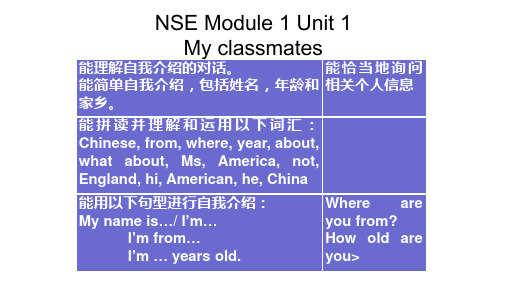module1 unit1
- 格式:ppt
- 大小:1.25 MB
- 文档页数:32



外研版英语九(上)Module 1 Wonders of the world知识点详解Unit 1What is a wonder of the world?★(A3).【知识点再现】Let’s call Wonder of the World and join in the discussion. 我们给《世界奇观》节目打电话,加入讨论吧。
【知识点1】wonder可作动词或名词,其用法如下:①wonder作名词,意为“奇迹;奇观”时,是可数名词,其复数形式为wonders。
如:We have visited many wonders of the world. 我们已经参观了许多世界奇观。
The Great Wall is one of the seven wonders of the world. 长城是世界上七大奇迹之一。
②wonder作名词,意为“惊叹;惊奇”时,是不可数名词。
常用的句型有:It’s a wonder that...令人惊奇的是……;It’s no wonder that... 难怪……。
如:It’s no wonder that he is late. 难怪他迟到了。
It’s a wonder (that) more people weren’t hurt. 奇怪的是没有更多的人受到伤害。
③wonder作动词,意为“想知道”,相当于want to know,后面接who, what, why, where, if或that等引导的宾语从句或“疑问词+不定式”构成的短语。
如:I wonder who she is. 我想知道她是谁。
She wondered what the child was doing. 她感到疑惑,孩子究竟在干什么。
I wonder why Ann is late. 我想知道安为什么迟到了。
I wonder (that) she has won the race. 我对她赢了比赛感到惊讶。



外研版 英语 五年级上册Module 1Unit 1 Did you come back yesterday?第一课时第二课时第一课时Free talk.Did you have a good summer holiday?Where did you go?What did you do?Guess: Where did I go and what did I do on summer holiday?I went to London.go-wentI met a friend.meet-metWe visited the London Eye andBig Ben.visit-visitedWe saw many oldbuildings.see-sawLet’s chant together.Lingling went to London Town.She met John, a little boy.They visited the London Eye,and saw the city from above the ground .Lingling went to London Town.此句是一般过去时态的句子,表示过去某一时刻或一段时间所发生的事情或存在的状态。
Went 是实义动词 go 的过去式。
句型结构:主语 + 过去式+ 其他。
I did my homework.I was young in this picture.Listen, read and act out.Is Lingling a Chinese?Where is she now?When did she go?Lingling is in London with Sam and Amy.They met John one day. Let’s see what happened.Listen and answer.1. Did Amy come back to London yesterday?No, she didn’t.2. Does John live near Amy and Sam?Yes, he does.3. Did Lingling drop her ice cream?Yes, she did.Did Amy come back yesterday?todaylast Sunday指一指today yesterday last Sunday last Saturday last weeklast weekend last month last yearGame.开火车以列为单位,从每列第一位同学开始,每人说一个表示过去的时间词,后面的同学不能重复。
Unit1 知识点归纳【句型】1.I’m your teacher and you’re my students.我是你们的老师,你们是我的学生。
英语里经常把两个或更多意思上关系很密切的句子合并成一个并列句。
并列句可以用and 连接,如:He’s English and he’s in Class One. 他是英国人,他在一班。
2. I’m from Wuhan.我来自武汉。
be from 表示“来自哪里” 。
如:I am from China. 我来自中国。
He’s from America. 他来自美国。
【拓展1】be from = come fromThey’re from England. = They come from England.他们来自英国。
【拓展2】如果不强调从哪里来, 只是要说明身份, 也可以说:I am Chinese. 我是中国人。
He is American. 他是美国人。
They’re English. 他们是英国人。
3. Where are you from?你来自哪里?Where+ is/are+主语+from?—Where is Sam from? 萨姆来自哪里?—He is from America. 他来自美国—Where are they from? 他们来自哪里?—They are from America. 他们来自美国。
4. I’m twelve years old. 我12岁。
…years old, 表示“……岁”,可省略。
如:Her dog is three (years old). 她的小狗3岁。
【拓展】对该句型提问可用:How old ...?--How old are you? 你多大了?--I am thirteen (years old). 我十三岁。
5. Nice to meet you. 很高兴见到你!这是两位初次见面相识后的用语, 意思是“见到你很高兴。
外研版八上英语《Module 1Unit 1 》说课稿一. 教材分析《Module 1 Unit 1》是外研版八年级上册英语教材的第一单元第一课时,本节课的主要内容是介绍一些基本的日常用语和问候语。
教材主要包括三个部分:听力、口语和阅读。
通过本节课的学习,学生能够掌握一些基本的日常用语,提高他们的听说能力。
二. 学情分析八年级的学生已经具备了一定的英语基础,他们对学习英语有着浓厚的兴趣。
但部分学生在发音和听力方面还存在一些问题,因此,在教学过程中需要特别关注这部分学生的学习情况,帮助他们提高英语水平。
三. 说教学目标1.知识目标:学生能够掌握一些基本的日常用语和问候语,如“Hello”,“Good morning”,“How are you?”等。
2.能力目标:通过听力、口语和阅读的训练,提高学生的英语听说能力。
3.情感目标:激发学生学习英语的兴趣,培养他们积极向上的学习态度。
四. 说教学重难点1.重点:学生能够熟练掌握并运用基本的日常用语和问候语。
2.难点:学生能够正确理解并运用英语进行简单的交流。
五. 说教学方法与手段1.采用任务型教学法,让学生在完成任务的过程中学习英语,提高他们的实践能力。
2.运用多媒体教学手段,如PPT、视频等,丰富教学内容,激发学生的学习兴趣。
3.小组合作学习,鼓励学生互相交流、互相帮助,提高他们的团队协作能力。
六. 说教学过程1.导入:教师通过与学生打招呼,引入本节课的主题,让学生初步感受日常用语的重要性。
2.听力训练:教师播放听力材料,学生听后回答相关问题,提高他们的听力能力。
3.口语练习:教师引导学生进行角色扮演,运用所学日常用语进行交流,提高他们的口语表达能力。
4.阅读理解:教师分发阅读材料,学生阅读后回答相关问题,增强他们的阅读理解能力。
5.巩固提高:教师学生进行小组讨论,运用所学知识进行实际交流,巩固所学内容。
6.总结反馈:教师对学生的学习情况进行总结,给予鼓励和指导,帮助学生提高。
Module 1 Unit 1 It's more than twenty thousand kilometres long.第一模块第一单元它有二万多公里长Activity 1 Listen and chant.活动1 听一听,并说唱This is the Great Wall.这是长城。
It's very beautiful.它非常美丽。
It's long and old.它既长又古老。
And we love it all.我们都喜欢它。
Activity 2 Listen,read and act out.活动2 听一听,读一读,并表演Daming is visiting the US. He's in New York with his cousin Simon.大明正在游览美国。
他和他表哥西蒙在纽约。
Simon: These postcards are great!西蒙:这些明信片太棒了!Daming: Yes, they are. And look at this one. It's a pictureof the Great Wall.大明:是的,它们很棒。
看这一张。
它是一张长城的图片。
Simon: Tell me more about the Great Wall. How long is it? 西蒙:告诉我更多关于长城的信息。
它多长?Daming: It's more than twenty thousand kilometres long. 大明:它有两万多公里长。
Simon: Wow! It's really long!西蒙:哇!它真长!Daming: Can you tell me something about New York? How big is it?大明:你能告诉我一些关于纽约的事情吗?它多大?Simon: It's very big. It has got more than eight million people.西蒙:它非常大。
外研版英语八(下)Module 1 Feelings and impressions 知识点详解Unit 1It smells delicious.Unit 1 It smells delicious.★(A3).【知识点再现】What a delicious smell! 多香的味道啊!【知识点1】本句是一个感叹句。
感叹句通常由what或how引导,表示惊讶、赞美、喜悦、愤怒等感情。
what通常修饰名词,how通常修饰形容词或副词。
感叹句的结构如下:①“What + a/an+形容词+可数名词单数形式(+主语+谓语)!”What a useful book! 多么有用的一本书啊!What a clever boy! 多么聪明的男孩!What an old tree it is! 多么古老的一棵树啊!What a beautiful flower! 多么漂亮的一朵花啊!②“What+形容词+可数名词复数/不可数名词(+主语+谓语)!”What good children they are!他们是多么好的孩子啊!What beautiful flowers they are! 他们是多么漂亮的花啊!What delicious food it is! 它是多么美味的食物啊!What heavy snow it is! 它是多么大的雪啊!③“How+形容词或副词(+主语+谓语)!”How lovely the baby is! 婴儿多么可爱啊!How fast he is running! 他跑得多么快啊!【拓展】感叹句在表示激动、强烈的感情时,口语中常常采用省略的形式,即后面的主语和谓语往往省略。
如:What a fine day! 多么晴朗的天气啊!How wonderful! 精彩极了!★(A3).【知识点再现】Y our pizza looks so nice. 你的比萨饼看起来如此的好。
【知识点2】本句是主系表结构,句中look是感官系动词,意为“看上去;看起来”,后面常接形容词或介词短语作表语。